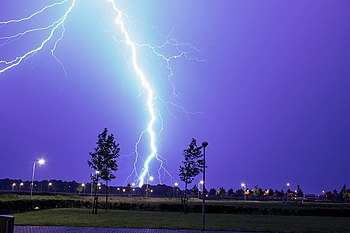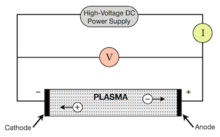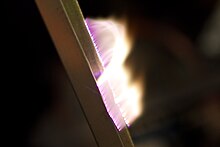Plasma (physics)
Plasma (from
The presence of
Depending on temperature and density, a certain number of neutral particles may also be present, in which case plasma is called
Unlike the phase transitions between the other three states of matter, the transition to plasma is not well defined and is a matter of interpretation and context.[10] Whether a given degree of ionization suffices to call a substance "plasma" depends on the specific phenomenon being considered.Early history
Plasma was first identified in laboratory by
Except near the electrodes, where there are sheaths containing very few electrons, the ionized gas contains ions and electrons in about equal numbers so that the resultant space charge is very small. We shall use the name plasma to describe this region containing balanced charges of ions and electrons.
Lewi Tonks and Harold Mott-Smith, both of whom worked with Langmuir in the 1920s, recall that Langmuir first used the term by analogy with the blood plasma.[13][14] Mott-Smith recalls, in particular, that the transport of electrons from thermionic filaments reminded Langmuir of "the way blood plasma carries red and white corpuscles and germs."[15]
| Part of a series on |
| Continuum mechanics |
|---|
Definitions
The fourth state of matter
Plasma is called the fourth
Plasma is typically an electrically quasineutral medium of unbound positive and negative particles (i.e. the overall charge of a plasma is roughly zero). Although these particles are unbound, they are not "free" in the sense of not experiencing forces. Moving charged particles generate electric currents, and any movement of a charged plasma particle affects and is affected by the fields created by the other charges. In turn, this governs collective behaviour with many degrees of variation.[21][22]
Plasma is distinct from the other states of matter. In particular, describing a low-density plasma as merely an "ionized gas" is wrong and misleading, even though it is similar to the gas phase in that both assume no definite shape or volume. The following table summarizes some principal differences:
State Property |
Gas | Plasma |
|---|---|---|
| Interactions | Short-range: Two-particle (binary) collisions are the rule. | Long-range: Collective motion of particles is ubiquitous in plasma, resulting in various waves and other types of collective phenomena.
|
| Electrical conductivity | Very low: Gases are excellent insulators up to electric field strengths of tens of kilovolts per centimetre.[23] | Very high: For many purposes, the conductivity of a plasma may be treated as infinite. |
| Independently acting species | One: All gas particles behave in a similar way, largely influenced by collisions with one another and by gravity. | Two or more: Electrons and ions possess different charges and vastly different masses, so that they behave differently in many circumstances, with various types of plasma-specific waves and instabilities emerging as a result. |
Ideal plasma
Three factors define an ideal plasma:[24][25]
- The plasma approximation: The plasma approximation applies when the
- Bulk interactions: The Debye length is much smaller than the physical size of the plasma. This criterion means that interactions in the bulk of the plasma are more important than those at its edges, where boundary effects may take place. When this criterion is satisfied, the plasma is quasineutral.[28]
- Collisionlessness: The electron plasma frequency (measuring plasma oscillations of the electrons) is much larger than the electron–neutral collision frequency. When this condition is valid, electrostatic interactions dominate over the processes of ordinary gas kinetics. Such plasmas are called collisionless.[29]
Non-neutral plasma
The strength and range of the electric force and the good conductivity of plasmas usually ensure that the densities of positive and negative charges in any sizeable region are equal ("quasineutrality"). A plasma with a significant excess of charge density, or, in the extreme case, is composed of a single species, is called a
Dusty plasma
A dusty plasma contains tiny charged particles of dust (typically found in space). The dust particles acquire high charges and interact with each other. A plasma that contains larger particles is called grain plasma. Under laboratory conditions, dusty plasmas are also called complex plasmas.[31]
Properties and parameters
Density and ionization degree
For plasma to exist, ionization is necessary. The term "plasma density" by itself usually refers to the electron density , that is, the number of charge-contributing electrons per unit volume. The degree of ionization is defined as fraction of neutral particles that are ionized:
where is the ion density and the neutral density (in number of particles per unit volume). In the case of fully ionized matter, . Because of the quasineutrality of plasma, the electron and ion densities are related by , where is the average ion charge (in units of the elementary charge).
Temperature
Plasma temperature, commonly measured in
In most cases, the electrons and heavy plasma particles (ions and neutral atoms) separately have a relatively well-defined temperature; that is, their energy
Plasma potential

Since plasmas are very good electrical conductors, electric potentials play an important role.[clarification needed] The average potential in the space between charged particles, independent of how it can be measured, is called the "plasma potential", or the "space potential". If an electrode is inserted into a plasma, its potential will generally lie considerably below the plasma potential due to what is termed a Debye sheath. The good electrical conductivity of plasmas makes their electric fields very small. This results in the important concept of "quasineutrality", which says the density of negative charges is approximately equal to the density of positive charges over large volumes of the plasma (), but on the scale of the
The magnitude of the potentials and electric fields must be determined by means other than simply finding the net charge density. A common example is to assume that the electrons satisfy the Boltzmann relation:
Differentiating this relation provides a means to calculate the electric field from the density:
It is possible to produce a plasma that is not quasineutral. An electron beam, for example, has only negative charges. The density of a non-neutral plasma must generally be very low, or it must be very small, otherwise, it will be dissipated by the repulsive
Magnetization
The existence of charged particles causes the plasma to generate, and be affected by, magnetic fields. Plasma with a magnetic field strong enough to influence the motion of the charged particles is said to be magnetized. A common quantitative criterion is that a particle on average completes at least one gyration around the magnetic-field line before making a collision, i.e., , where is the electron
Mathematical descriptions

To completely describe the state of a plasma, all of the particle locations and velocities that describe the electromagnetic field in the plasma region would need to be written down. However, it is generally not practical or necessary to keep track of all the particles in a plasma.[citation needed] Therefore, plasma physicists commonly use less detailed descriptions, of which there are two main types:
Fluid model
Fluid models describe plasmas in terms of smoothed quantities, like density and averaged velocity around each position (see
Kinetic model
Kinetic models describe the particle velocity distribution function at each point in the plasma and therefore do not need to assume a Maxwell–Boltzmann distribution. A kinetic description is often necessary for collisionless plasmas. There are two common approaches to kinetic description of a plasma. One is based on representing the smoothed distribution function on a grid in velocity and position. The other, known as the particle-in-cell (PIC) technique, includes kinetic information by following the trajectories of a large number of individual particles. Kinetic models are generally more computationally intensive than fluid models. The Vlasov equation may be used to describe the dynamics of a system of charged particles interacting with an electromagnetic field. In magnetized plasmas, a gyrokinetic approach can substantially reduce the computational expense of a fully kinetic simulation.[citation needed]
Plasma science and technology
Plasmas are studied by the vast
Plasmas can appear in nature in various forms and locations, with a few examples given in the following table:
| Artificially produced | Terrestrial plasmas | Space and astrophysical plasmas |
|---|---|---|
|
|
|
Space and astrophysics
Plasmas are by far the most common phase of ordinary matter in the universe, both by mass and by volume.[42]
Above the Earth's surface, the ionosphere is a plasma,
Artificial plasmas
Most artificial plasmas are generated by the application of electric and/or magnetic fields through a gas. Plasma generated in a laboratory setting and for industrial use can be generally categorized by:
- The type of power source used to generate the plasma—DC, AC (typically with radio frequency (RF)) and microwave[citation needed]
- The pressure they operate at—vacuum pressure (< 10 mTorr or 1 Pa), moderate pressure (≈1 Torr or 100 Pa), atmospheric pressure (760 Torr or 100 kPa)[citation needed]
- The degree of ionization within the plasma—fully, partially, or weakly ionized[citation needed]
- The temperature relationships within the plasma—thermal plasma (), non-thermal or "cold" plasma ()[citation needed]
- The electrode configuration used to generate the plasma[citation needed]
- The magnetization of the particles within the plasma—magnetized (both ion and electrons are trapped in Larmor orbits by the magnetic field), partially magnetized (the electrons but not the ions are trapped by the magnetic field), non-magnetized (the magnetic field is too weak to trap the particles in orbits but may generate Lorentz forces)[citation needed]
Generation of artificial plasma


Just like the many uses of plasma, there are several means for its generation. However, one principle is common to all of them: there must be energy input to produce and sustain it.
The
Electric arc


Electric arc is a continuous electric discharge between two electrodes, similar to lightning.
With ample current density, the discharge forms a luminous arc, where the inter-electrode material (usually, a gas) undergoes various stages — saturation, breakdown, glow, transition, and thermal arc. The voltage rises to its maximum in the saturation stage, and thereafter it undergoes fluctuations of the various stages, while the current progressively increases throughout.
Examples of industrial plasma
Plasmas find applications in many fields of research, technology and industry, for example, in industrial and extractive
Low-pressure discharges
- fluorescent light tubes.[56]
- 13.56 MHz. These differ from glow discharges in that the sheaths are much less intense. These are widely used in the microfabrication and integrated circuit manufacturing industries for plasma etching and plasma enhanced chemical vapor deposition.[57]
- Cascaded arc plasma source: a device to produce low temperature (≈1eV) high density plasmas (HDP).
- Inductively coupled plasma (ICP): similar to a CCP and with similar applications but the electrode consists of a coil wrapped around the chamber where plasma is formed.[58]
- helicon discharge and electron cyclotron resonance (ECR).[59]
Atmospheric pressure
- Arc discharge: this is a high power thermal discharge of very high temperature (≈10,000 K). It can be generated using various power supplies. It is commonly used in metallurgical processes. For example, it is used to smelt minerals containing Al2O3 to produce aluminium.[citation needed]
- Corona discharge: this is a non-thermal discharge generated by the application of high voltage to sharp electrode tips. It is commonly used in ozone generators and particle precipitators.[citation needed]
- Dielectric barrier discharge (DBD): this is a non-thermal discharge generated by the application of high voltages across small gaps wherein a non-conducting coating prevents the transition of the plasma discharge into an arc. It is often mislabeled "Corona" discharge in industry and has similar application to corona discharges. A common usage of this discharge is in a plasma actuator for vehicle drag reduction.[60] It is also widely used in the web treatment of fabrics.[61] The application of the discharge to synthetic fabrics and plastics functionalizes the surface and allows for paints, glues and similar materials to adhere.[62] The dielectric barrier discharge was used in the mid-1990s to show that low temperature atmospheric pressure plasma is effective in inactivating bacterial cells.[63] This work and later experiments using mammalian cells led to the establishment of a new field of research known as plasma medicine. The dielectric barrier discharge configuration was also used in the design of low temperature plasma jets. These plasma jets are produced by fast propagating guided ionization waves known as plasma bullets.[64]
- 13.56 MHz) to one powered electrode, with a grounded electrode held at a small separation distance on the order of 1 cm. Such discharges are commonly stabilized using a noble gas such as helium or argon.[65]
- "Piezoelectric direct discharge plasma:" is a nonthermal plasma generated at the high-side of a piezoelectric transformer (PT). This generation variant is particularly suited for high efficient and compact devices where a separate high voltage power supply is not desired.[citation needed]
MHD converters
A world effort was triggered in the 1960s to study magnetohydrodynamic converters in order to bring MHD power conversion to market with commercial power plants of a new kind, converting the kinetic energy of a high velocity plasma into electricity with no moving parts at a high efficiency. Research was also conducted in the field of supersonic and hypersonic aerodynamics to study plasma interaction with magnetic fields to eventually achieve passive and even active flow control around vehicles or projectiles, in order to soften and mitigate shock waves, lower thermal transfer and reduce drag.[citation needed]
Such ionized gases used in "plasma technology" ("technological" or "engineered" plasmas) are usually weakly ionized gases in the sense that only a tiny fraction of the gas molecules are ionized.
Complex plasma phenomena
Although the underlying equations governing plasmas are relatively simple, plasma behaviour is extraordinarily varied and subtle: the emergence of unexpected behaviour from a simple model is a typical feature of a complex system. Such systems lie in some sense on the boundary between ordered and disordered behaviour and cannot typically be described either by simple, smooth, mathematical functions, or by pure randomness. The spontaneous formation of interesting spatial features on a wide range of length scales is one manifestation of plasma complexity. The features are interesting, for example, because they are very sharp, spatially intermittent (the distance between features is much larger than the features themselves), or have a fractal form. Many of these features were first studied in the laboratory, and have subsequently been recognized throughout the universe.[citation needed] Examples of complexity and complex structures in plasmas include:
Filamentation
Striations or string-like structures,
Filamentation also refers to the self-focusing of a high power laser pulse. At high powers, the nonlinear part of the
Impermeable plasma
Impermeable plasma is a type of thermal plasma which acts like an impermeable solid with respect to gas or cold plasma and can be physically pushed. Interaction of cold gas and thermal plasma was briefly studied by a group led by
Gallery
-
Solar plasma
-
Plasma spraying
-
Plasma in a tokamak
-
Laboratory plasma
See also
To From
|
Solid | Liquid | Gas | Plasma |
|---|---|---|---|---|
| Solid | Melting | Sublimation | ||
| Liquid | Freezing | Vaporization | ||
| Gas | Deposition | Condensation | Ionization | |
| Plasma | Recombination |
References
- ^ Liddell, Henry George; Scott, Robert (1940). "πλάσμα". A Greek-English Lexicon. Clarendon Press. Retrieved 10 February 2023.
- ISBN 978-1-4665-0990-0.
- ISBN 978-3-642-10491-6. Archivedfrom the original on 5 January 2016.
- ^
Phillips, K. J. H. (1995). Guide to the Sun. ISBN 978-0-521-39788-9. Archivedfrom the original on 15 January 2018.
- ISBN 978-3-540-22321-4.
- ISBN 978-88-470-5280-2.
- ISBN 978-1-4398-8132-3.
- ISBN 978-1-4665-0990-0.
- ^ "How Lightning Works". HowStuffWorks. April 2000. Archived from the original on 7 April 2014.
- ISBN 978-1-4398-8132-3.
- ^ "Find in a Library: On radiant matter a lecture delivered to the British Association for the Advancement of Science, at Sheffield, Friday, August 22, 1879". Archived from the original on 9 July 2006. Retrieved 24 May 2006. "Radiant Matter". Archived from the original on 13 June 2006. Retrieved 24 May 2006.
- PMID 16587379.
- .
- ISBN 978-0-12-349701-7. Archivedfrom the original on 23 October 2017.
- PMID 16063290.
- ISBN 9781468418965. Archivedfrom the original on 15 January 2018.
- ISBN 978-0-85274-164-1, 226 pages, page 5
- ISBN 9780387209753. Archivedfrom the original on 2 February 2017.
- ^ ISBN 9781475755954. Archivedfrom the original on 15 January 2018.
- ^ ISBN 9781139462150. Archivedfrom the original on 24 December 2016.
- ISBN 978-0-521-44810-9.
- ISBN 978-0-7382-0047-7.
- ^ Hong, Alice (2000). Elert, Glenn (ed.). "Dielectric Strength of Air". The Physics Factbook. Retrieved 6 July 2018.
- ISBN 978-0-19-852041-2. Archivedfrom the original on 15 January 2018.
- ISBN 978-0-521-47128-2.
- from the original on 15 January 2018.
- . Retrieved 19 March 2021.
- ^ "Quasi-neutrality - The Plasma Universe theory (Wikipedia-like Encyclopedia)". www.plasma-universe.com. Archived from the original on 26 October 2017. Retrieved 25 October 2017.
- S2CID 250739485. Retrieved 19 March 2021.
- doi:10.1063/1.870693.
- .
- ^ "Plasma Fountain". pwg.gsfc.nasa.gov. Retrieved 10 February 2023.
- ISBN 978-0-471-09045-8.
- ^ Hamrang, Abbas (2014). Advanced Non-Classical Materials with Complex Behavior: Modeling and Applications, Volume 1. CRC Press. p. 10.
- ISSN 1070-664X.
- ^ NASA Administrator (7 June 2013). "Flashes in the Sky: Earth's Gamma-Ray Bursts Triggered by Lightning". NASA. Retrieved 10 February 2023.
- S2CID 122977170. Retrieved 15 July 2021.
- )
- ^ Fitzpatrick, Richard. "Magnetized Plasmas". Introduction to Plasma Physics. Retrieved 10 February 2023.
- ^ Alfven, H.; Arrhenius, G. (January 1976). "chapter 15". history.nasa.gov. Retrieved 10 February 2023.
- hdl:2027.42/70486.
- ISBN 978-3-540-22907-0..
- ISBN 9780120884254.
- ISBN 0-87590-026-7. Archived from the originalon 3 May 2012. Retrieved 25 August 2018.
- ISBN 978-1-139-49072-6.
- ISBN 978-1-84816-382-9.
- ^ "APOD: 2004 December 11 - M87's Energetic Jet". apod.nasa.gov. Retrieved 10 February 2023.
- ^ ISBN 978-3-527-40673-9.
- ISBN 978-0-306-41332-2. Archivedfrom the original on 15 January 2018.
- ^ .
- ^ S2CID 206069219.
- PMID 28773804.
- ISBN 978-0-309-04597-1.
- S2CID 116995929.
- ^ Peretich, M.A.; O'Brien, W.F.; Schetz, J.A. (2007). "Plasma torch power control for scramjet application" (PDF). Virginia Space Grant Consortium. Archived from the original (PDF) on 29 June 2010. Retrieved 12 April 2010.
{{cite journal}}: Cite journal requires|journal=(help) - ^ Stern, David P. "The Fluorescent Lamp: A plasma you can use". Archived from the original on 30 May 2010. Retrieved 19 May 2010.
- doi:10.1116/1.589774. Archived from the original(PDF) on 18 January 2009.
- .
- ISBN 9781139471732. Archivedfrom the original on 2 February 2017.
- .
- S2CID 137392051.
- PMID 18930244.
- .
- .
- .
- OCLC 690642377.
- Bibcode:1990BAAS...22..832D.
- .
- .
- doi:10.1086/148107.
- ^ "Hubble views the Crab Nebula M1: The Crab Nebula Filaments". Archived from the original on 5 October 2009. Retrieved 26 January 2017.
{{cite web}}: CS1 maint: bot: original URL status unknown (link). The University of Arizona - .
- )
- .
- S2CID 26797662.
- .
- PMID 23330064.
External links
- Plasmas: the Fourth State of Matter Archived 30 September 2019 at the Wayback Machine
- Introduction to Plasma Physics: Graduate course given by Richard Fitzpatrick|M.I.T. Introduction by I.H.Hutchinson
- Plasma Material Interaction
- How to make a glowing ball of plasma in your microwave with a grape Archived 6 September 2005 at the Wayback Machine|More (Video)
- OpenPIC3D – 3D Hybrid Particle-In-Cell simulation of plasma dynamics
- Plasma Formulary Interactive





























